|
Chapter
V: The Clock, "Hortense the Beautiful" - Her Seth
Thomas & McShane Bell Co. Records, Including Costs &
Weights
|
|
Seth Thomas Clock Company was
one of the most prolific and
long lived clock companies. The
quality of their products was
always maintained at an above
average level. Seth Thomas must
have sold many clocks in the
Lafayette, Indiana area, for out
of all the antique clocks we
repair, about 40% are made by
Seth Thomas.
Many American clock factories in
the 19th century suffered
factory fires but Seth Thomas
was fortunate in this respect.
Through conservative growth and
taking advantage of the new
ideas of others, Seth Thomas was
able to enjoy financial
stability, whereas many other
companies faced financial
difficulties.
Seth Thomas was born in Wolcott,
Connecticut in 1785, went to
work for clockmaker Eli Terry in
1807, bought out Terry's factory
(together with Silas Hoadley) in
1810, and in December 1813
bought out Heman Clark's
clock-making business in Plymouth
Hollow.
Thomas continued Clark's wooden
movement tall clock production,
and about 1817 began making the
wooden movement shelf clock.
These were cased in pillar and
scroll cases until 1830, when
the bronze looking glass and
other styles became popular. In
1842, brass movements were
introduced, and first cased in
the popular O.G. case (which was
made until 1913). Wood movements
were phased out in 1845. In 1853
Mr. Thomas incorporated the Seth
Thomas Clock Company, so that
the business would outlive him.
Mr. Thomas died in 1859, and
Plymouth Hollow was renamed
Thomaston in his honor in 1865.
Many Seth Thomas clocks from
1881 to 1918 have a date code
stamped in ink on the case back
or bottom. Usually, the year is
done in reverse, followed by a
letter A—L representing the
month. For example, April 1897
would appear as 7981 D.
In 1930 a holding company named
General Time Instruments
Corporation was formed to unite
Seth Thomas Clock Company with
Western Clock Company.
In 1955, a flood badly damaged
the Seth Thomas factory. They
phased out movement
manufacturing and began
importing many movements from
Germany. Hermle, in the Black
forest of Germany, has made many
movements for Seth Thomas
clocks.
|
History
from
Antique Seth
Thomas Clocks.com
|
In 1968, General Time was bought
by Talley Industries, and in
1979 the headquarters was moved
to Norcross, GA.
In June 2001 General Time
announced that it was closing
its entire operation. The
Colibri Group acquired Seth
Thomas. The NAWCC (the National
Association of Watch and Clock
collectors) purchased from Seth
Thomas their collection of
historical records, drawings,
photographs, advertisements and
documents.
In January, 2009, The Colibri
Group unexpectedly shut its
doors, laying off its 280
employees and preparing to sell
all remaining jewelry, gold and
silver to pay creditors. I don't
know yet what this means for
Seth Thomas.
The following message appeared
on the Colibri website:
February 16, 2009
The Colibri Group is currently
in receivership and is not
accepting any orders at this
time. We are also unable to
repair or replace any items
returned to us for the time
being. We will do our best to
ensure that items that have been
sent to us will be returned to
the respective customer or
owner. We will update this
message as new information
becomes available. We are sorry
for the inconvenience. Thank you
for your patience."
This history continues at
CLOCK HISTORY.COM |
|
|
|
HORTENSE'S
ACTUAL
MEASUREMENTS
&
COSTS FROM THE SETH
THOMAS CLOCK CO.
AND McSHANE BELL
CO.
|
|
Seth Thomas
Clock Co.
records show
that Hortense
was ordered for
Tampa City Hall
installation in
June 1914 and
assembly
completed in
May, 1915.
She was a Seth
Thomas No. 16, hour-strike
tower clock with
Graham
escapement.
Five other
locations in
Florida had same
model 16; one was
made for E. Neve
& Co. in Jan.
1882.
For
tower clocks, the Seth Thomas
serial number is their
production number.
Hortense was production No.
1906, she is found in book M for
clocks made from 11-Aug-1913 to
22-June-1915.
This explains why some newspaper articles
claim she was made in 1906, it's
on the plate fastened
to the front of the clock.
She was made in 1915, NOT 1906.
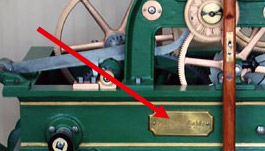
Chart at right is courtesy "Seth
Thomas Tower Clocks at
TSC Chapter 134.org |
Clock
Serial Number |
Book |
Dates |
| 1 to 360 |
Book A, |
from 12
July, 1872 to 24 April,
1877 |
| 361 to
502 |
Book B, |
from 28
April, 1877 to 30
January, 1885 |
| 503
to715 |
Book C, |
from 2
February, 1885 to 3
December, 1888 |
| 716 to
851 |
Book D, |
from 14
December, 1888 to 8
July, 1892 |
| 852 to
1013 |
Book E, |
from 9
July, 1892 to 13 May,
1895 |
| 1014 to
1100 |
Book F, |
from 13
May, 1895 to 19 May,
1899 |
| 1101 to
1248 |
Book G, |
from 19
May, 1899 to 28 May,
1901 |
| 1246 to
1408 |
Book H, |
from 28
May, 1901 to 20
February, 1904 |
| 1246 to
1407 |
Book I, |
from 26
February, 1904 to 4
January, 1906 |
| 1408 to
1594 |
Book J, |
from 3
January, 1906 to 17
December, 1909 |
| 1595 to
1738 |
Book K, |
from 11
January, 1910 to 21
December, 1911 |
| 1739 to
1840 |
Book L, |
from 3
January, 1912 to 19
August, 1913 |
|
1841 to 1951 |
Book M, |
from 11 August, 1913 to
22 June, 1915 |
| 1952 to
2051 |
Book N, |
from 26
June, 1915 to 20
October, 1917 |
| 2052 to
2145 |
Book O, |
from 7
December, 1917 to 18
March, 1920 |
| 2146 to
2266 |
Book P, |
from 13
April, 1920 to 9 August,
1922 |
| 2267 to
2400 |
Book Q, |
from 9
August, 1922 to 2 April,
1924 |
| 2401 to
2528 |
Book R, |
from 17
May, 1924 to 3 December,
1925 |
| 2529 to
2657 |
Book S, |
from 11
December, 1925 to 28
December, 1927 |
| 2658 to
2796 |
Book T, |
from 12
January, 1928 to 4
November, 1929 |
| 2797 to
2950 |
Book U, |
from 4
November, 1929 to 14
April, 1932 |
| 2951 to
? |
Book V, |
from 14
April, 1932 to 23 June,
1936 (Extrapolated) |
| ? + 1 to
?? |
Book W, |
from 23
June, 1936 to ----
(Extrapolated) |
|

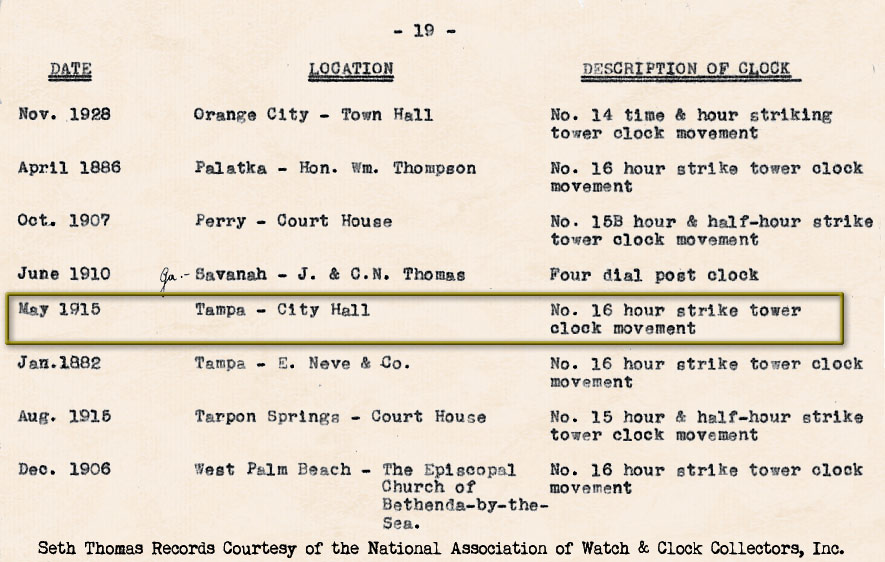
|
HORTENSE'S PRODUCTION
RECORDS
|
First page
Mouse-over the
image to see it
transcribed.
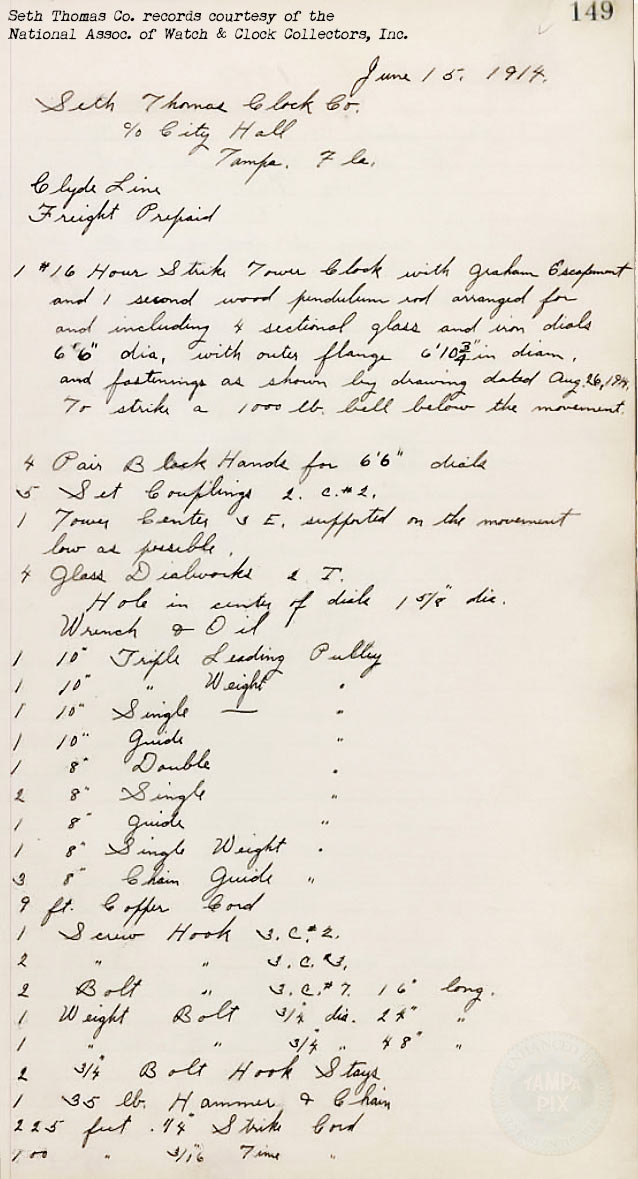
Second page
Mouse-over the
image to see it
transcribed.
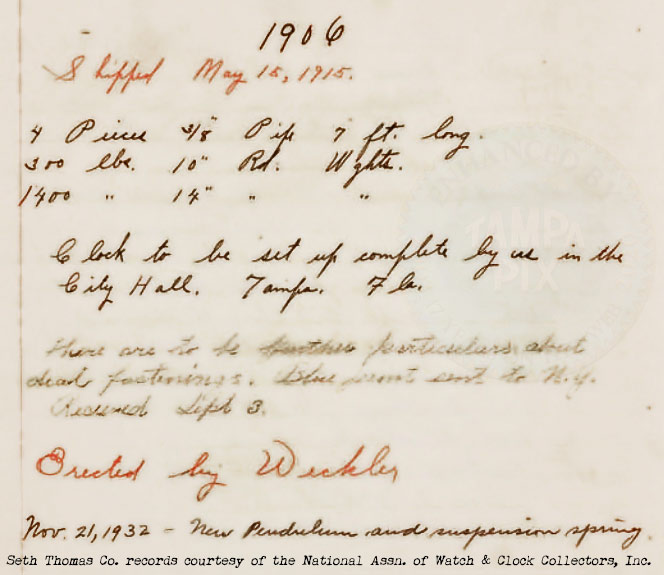
Notice above
Nov. 21, 1932
order of new
pendulum and
spring to
replace the
broken one
described in the
article below.
The pendulum did
NOT weigh 500
lbs.
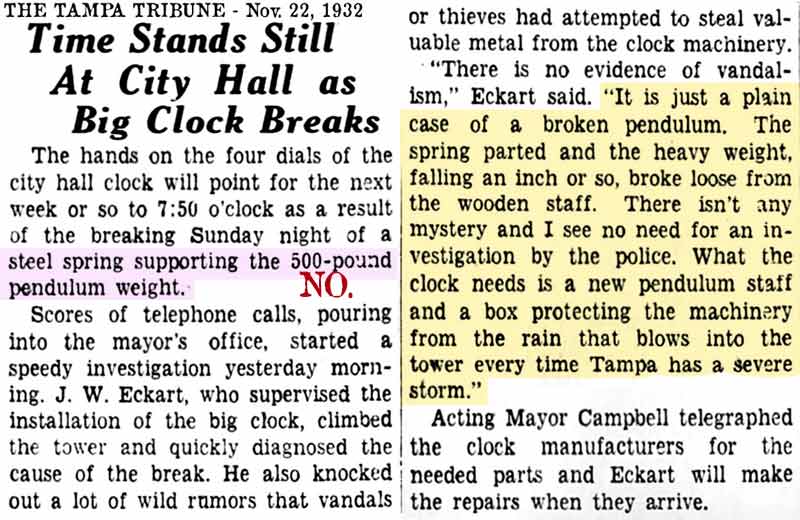
THE PENDULUM AND
SPRING
This screen shot
from a Trevor
Murphy video
featured below
shows him
pointing to the
spring that
suspends the
pendulum.
It appears to be
two metal plates
that are thin
enough to flex
from side to
side as the
pendulum swings.
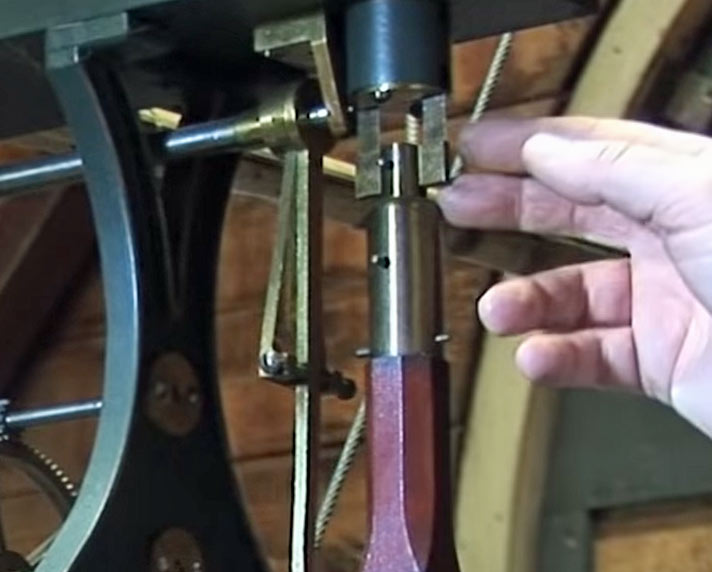

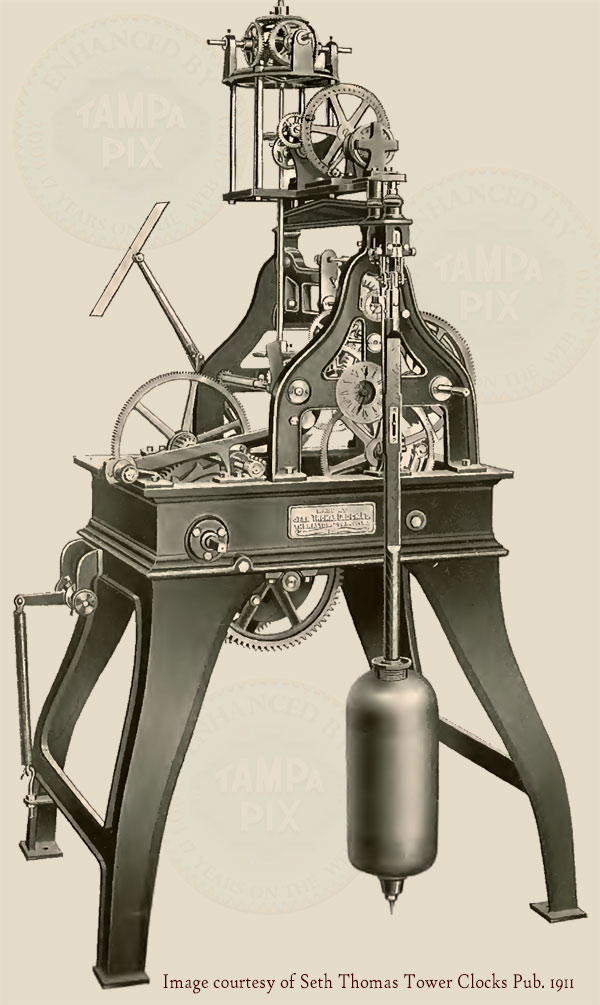
According to
this article,
the "monster
clock"
arrived in
SIXTEEN large
cases.
This is A LOT of
luggage, for a
clock, however,
figure it has
four faces and
each face is
made up of 6
"pie wedges"
glass backing
with its
corresponding
portion of the
dial. (The
bell has
increased 500
lbs. since the
previous
description and
the dials
increased
another
half-foot from
the previous
one.)
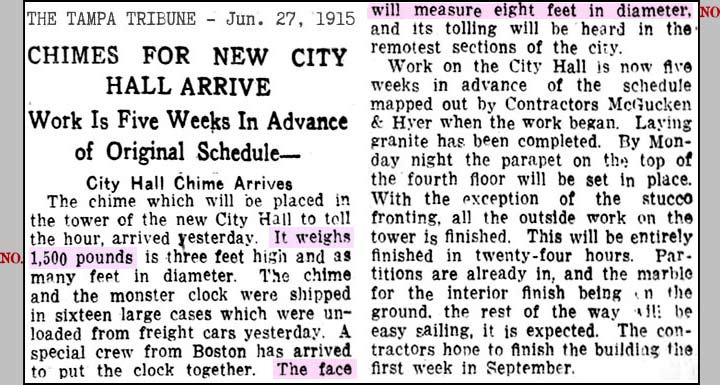
Trevor Murphy
has some
excellent
YouTube videos
which are very
well shot and
narrated.
HOOD
COUNTY
COURTHOUSE
TOWER
CLOCK,
TEXAS
The
Seth
Thomas
#16
Tower
Clock
seen
at
right
was
a
restoration
job
done
for
the
Hood
Co.
Texas
courthouse.
It
appears
to
be
identical
to
Hortense
except
that
the
gear
assembly
at
the
top
that
connects
to
the
clock
face
drive
shafts
aren't
attached
here.
The
object
sticking
up
in
the
back
can
also
be
seen
in
the
Seth
Thomas
diagram
above.
It
is
one
of
two
fan
blades
held
by
a
wooden
rod here.
The
actual
fan
blade
is
seen
on
edge.
Extending
downward
would
be
another
identical
rod
and
blade
and
together
the
whole
assembly
rotates
like
a
propeller.
The
plates
produce
a
wind
resistance
just
like
a
fan.
This
controls
the
speed
at
which
the
hammer
strikes
the
bell.
In
other
words,
it
acts
as a
"governor"
for
the
strike
mechanism
due
to
its
air
resistance.
Without
this,
the
weights
would
freefall
and
spin
the
drum
faster
and
faster,
while
the
hammer
would
beat
away
at
the
bell
like
a
jackhammer.
Until
the
weights
bottomed
out,
snapping
the
strike
cord,
and
continuing
to
plummet
through
a
floor
or
two
of
City
Hall.
(Not
to
mention
probably
sending
the
drive
chain
flying
through
a
wall.)
One
of
the
videos
below
show
this
mechanism
in
action. |
Seth
Thomas
Clocks
info
below
is
courtesy
of
Seth
Thomas
Tower
Clocks
(1911)
from SurvivorLibrary.com
Hortense
is a
#16
Seth
Thomas
Hour
Strike
tower
clock.
She
had
a
Graham
escapement
and
had
a 1
second
wood
pendulum.
She
had
four
sectional
glass
and
iron
dials
6 ft
6
in.
in
diameter.
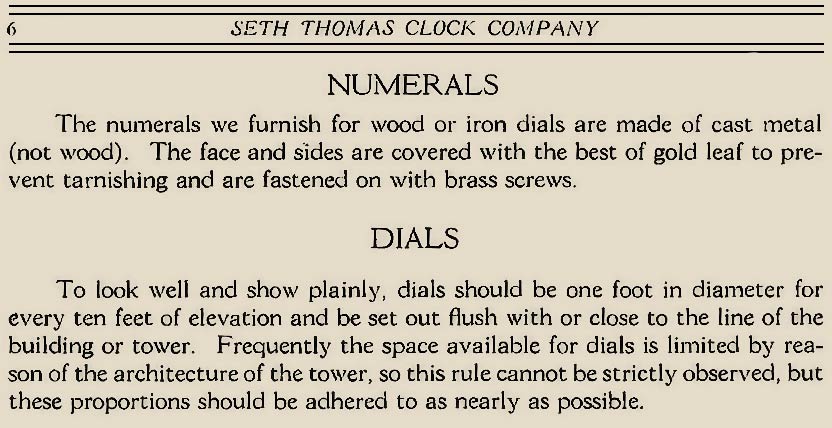
According
to a
few
newspaper
articles
published
during
construction
of
City
Hall,
and
installation
of
the
clock,
the
floor
of
the
room
where
the
clock
mechanism
is
housed
is
133.5
feet
above
ground.
Using
Seth
Thomas'
guide
for
dial
size,
Hortense's
dials
should
have
been
just
over
13
feet
in
diameter
for
optimum
visibility.

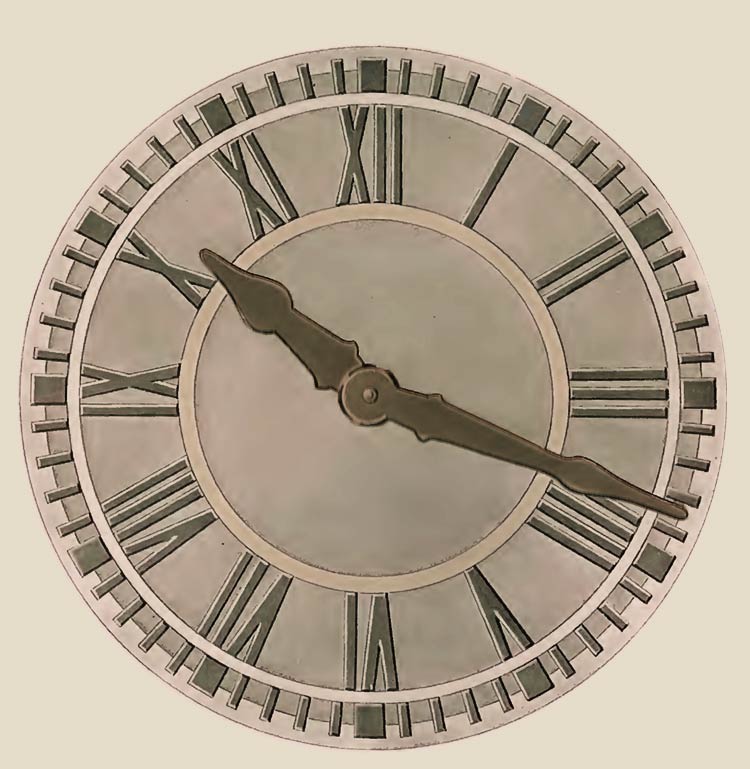
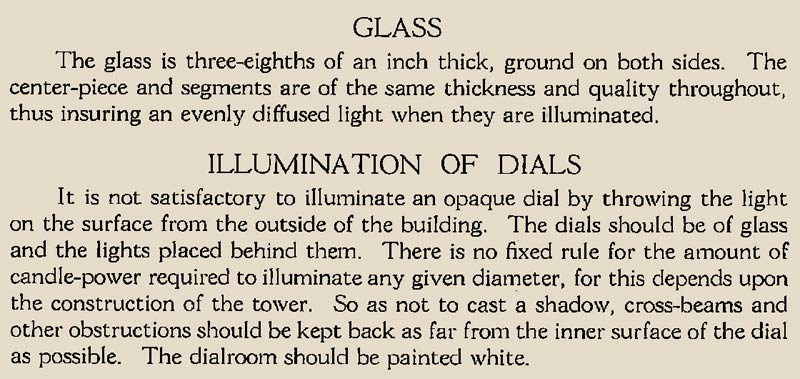
|
There
were
two
weights
that
powered
Hortense.
Ten-inch
round
weights
totaling
300
lbs.
ran
the
clock
mechanism,
which
was
suspended
by
100
ft.
of
5/16" dia.
"Time
Cord,"
and
fourteen-inch
round
weights
totaling
1,400
lbs.,
which powered
the
bell
strike
mechanism.
Those
weights
were
suspended
by
225
feet
of
.44" dia.
"Strike
Cord."
Much
more
weight
is
needed
to
lift
and
drop
the
heavy
THIRTY-FIVE
LB. bell
hammer.
As
you
will
see
in
one
of
the
videos
to
follow,
the
"Time
Cord"
is
wrapped
around
a
cylinder
in
ONE
LAYER
only.
This
is
because
a
second
layer
would
have
a
larger
diameter
winding
and
cause
a
different
value
torque
to
be
exerted
on
the
driving
gears.
BELOW
IS A
TYPICAL
INSTALL
ARRANGEMENT
FOR
A
#16
CLOCK
The
strike
cord
can
be
seen
on
the
left
and
the
time
cord
on
the
right.
Both
are
fastened
to
the
ceiling
first
and
then
to a
block
&
tackle
pulley
system
which
makes
rewinding
of
the
the
weights
easier
and
the
weights
themselves
to
require
less
drop
distance. |
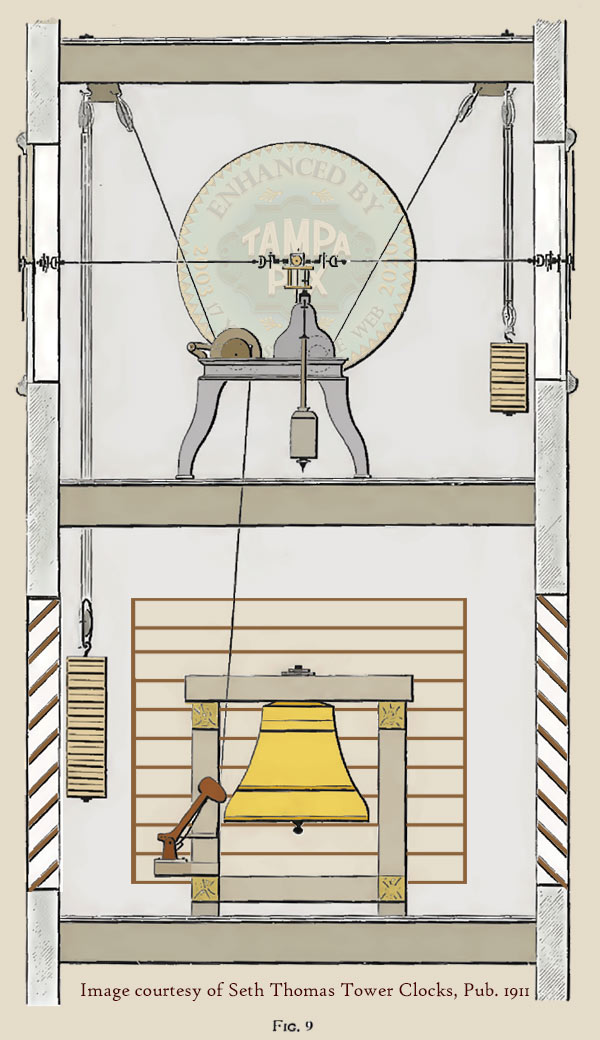
This
is
the
configuration
which
was
set
up
for
Hortense.
HORTENSE'S
PENDULUM
Two different
pendulums were
available for
the #16 tower
clock. A
four-foot long
one weighing 135
lbs. or an
eight-foot
long one
weighing 175
lbs. The 8
ft. one would
have required a
hole cut in the
floor for the
pendulum to
swing freely in
the bell room
below.
Being twice as
long, its period
would have been
2 seconds--1
second in each
direction. Hortense
had a 1-second
pendulum, so it
was the 4 ft.
one weighing 135
lbs. With
the clock itself
being 54 inches
tall, a 48-inch
long pendulum
wouldn't reach
the floor if
connected to the
clock six inches
or less from the
top.
HOW MUCH DID
HORTENSE WEIGH?
Assuming the
weight given for
the Seth Thomas
tower clocks
diagram seen at
left, they are
describing the
mechanism seen
in the diagram.
They couldn't
give the weight
with all the
attachments
because that
would be
different for
each order.
So it makes
sense that the
weight given
here is for just
what you see
here.
The 4 ft. long
pendulum with
135 lb. weight
seems to be
included in this
"box" because it
is shown along
with the clock
mechanism.
However, an 8
ft. pendulum
might have to be
shipped
separately,
unless it came
apart in two
4-ft sections.
The line about
the dials is
only there to
specify what a
#16 tower clock
can drive.
It was "FOR
ONE dial up to
10 feet [in diam.]
OR FOUR dials of
8.5 feet or
less.
Obviously, glass
dials wouldn't
be shipped in
the same box as
a device such as
seen at left.
They would
require more
protective
framing.
Same goes for
the bell, it's
giving a
suggested size,
not stating that
the bell is in
the same box
with the clock.
So Hortense
weighed about
1,500 lbs.
including the
crate.
This would
appear to have
included the 135
lb pendulum but
not her
bell nor her 35
lb hammer, and
definitely NOT
the four
sectional glass
faces with iron
dial rings (six
pieces per
face).
There is no
mention of the
weights which
drive the clock
and the ones
which power the
strike hammer,
so those must
have been
shipped
separately as
they alone
totaled 1,700
lbs. Then
there is the
weight of the
bell (which
McShane Bell Co.
will provide
below), which
also couldn't
possibly be part
of the approx.
1,500 lb boxed
weight they
describe.
THE
GRAHAM
ESCAPEMENT
George
Graham
(1673-1751)
of
London
was
an
English
clockmaker
and
inventor
and
a
member
of
the
Royal
Society.
He
was
partner
to
the
influential
English
clockmaker
Thomas
Tompion
during
the
last
few
years
of
Tompion's
life.
Graham
is
credited
with
inventing
several
design
improvements
to
the
pendulum
clock,
inventing
the
mercury
compensation
pendulum
and
also
the
cylinder
escapement
for
watches
and
the
first
chronograph.
However,
his
greatest
innovation
was
the
invention
of
the
Graham
or
dead
beat
escapement
around
1715.
Graham
refused
to
patent
these
inventions
because
he
felt
that
they
should
be
used
by
other
watchmakers.
George
Graham
is
said
to
have
modified
the
anchor
escapement
to
eliminate
recoil,
creating
the
deadbeat
escapement,
also
called
the
Graham
escapement.
This
has
been
the
escapement
of
choice
in
almost
all
finer
pendulum
clocks
since
then.
Graham
modified
the
arm
of
each
steel
pallet
so
that
the
lower
portion
of
each
limb
was
based
on
the
arc
of a
circle
with
its
center
at
the
axis
of
rotation
of
the
pallets
(see
Fig.
1).
The
tip
of
each
limb
had
a
surface,
the
angle
of
which,
based
on
force
directions,
was
designed
to
provide
an
impulse
to
the
pallet
as
the
escape
tooth
slid
across
the
surface
of
each
tip.
The
escape
tooth
strikes
the
pallet
above
the
tip
on
the
lower
portion
of
the
limb
(see
Fig.
2),
where
the
escape
wheel
is
rotating
clockwise
and
is
about
to
strike
the
entrance
pallet
on
the
left
side,
above
the
impulse
face.
The
surface
that
the
escape
tooth
strikes
is
the
locking
face,
since
it
prevents
the
escape
wheel
from
rotating
farther.
Info
and
images
below from
Princeton.edu
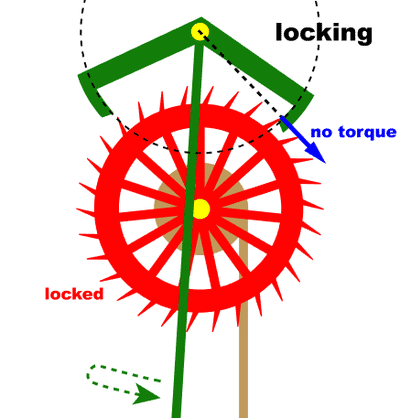
Animated GIF courtesy of
Wooster Physicists
"Deadbeat Escapement"
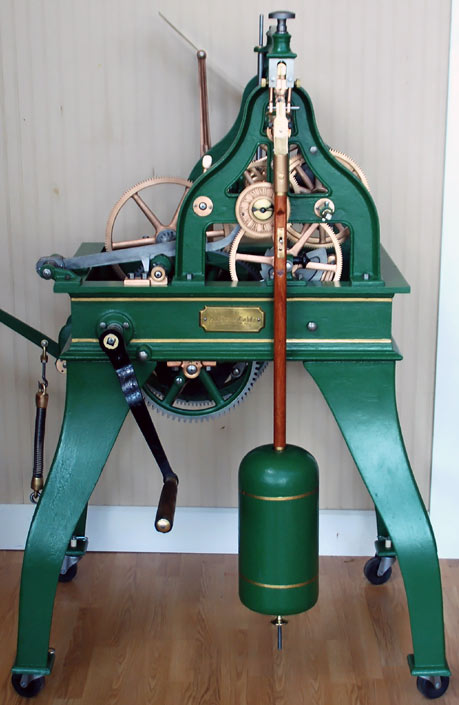
Photo
is
courtesy
of
the
South
West
Museum
of
Clocks
&
Watches
who
beautifully
restored
this
Seth
Thomas
tower
clock
in
its original colors.
|
|
|
Another
fascinating
video from
Trevor
Murphy:
THE FOUR
MAJOR PARTS
OF A TOWER
CLOCK
|
|
|
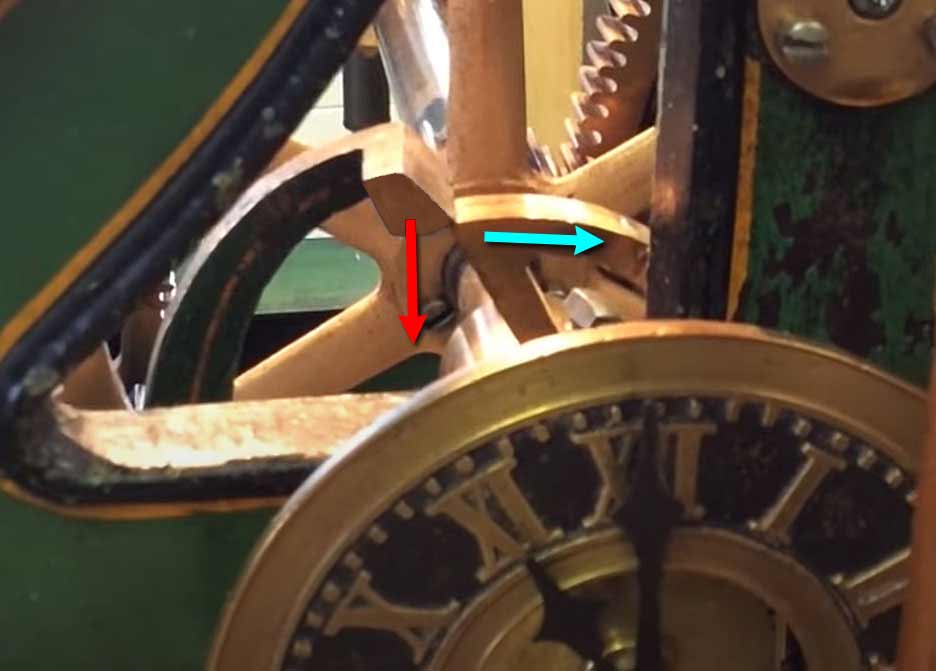
THIS
IS
AN
OLDER
SETH
THOMAS
BUT
VERY
SIMILAR
IN
DESIGN
TO
HORTENSE.
Just
before
it
chimes
at
11:00,
you
can
see
the
mechanism
that
controls
the
chime
count
at
the
very
edge
of
the
rotating
wheel.,
called
a
"snail."
The
count
mechanism
method
is
called
"rack
&
snail."
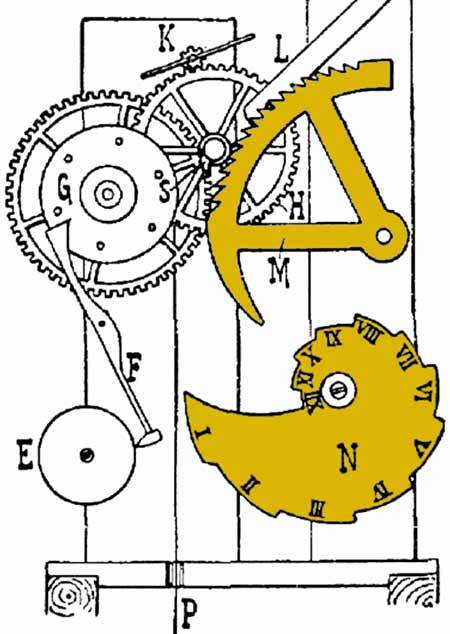 This
is
the
critical
part
that
releases
the
striking
train
at
the
proper
time
and
counts
out
the
proper
number
of
strikes.
It
is
the
only
part
of
the
striking
mechanism
that
is
attached
to
the
clock's
timekeeping
works.
Virtually
all
modern
clocks
use
the
rack
and
snail.
The
snail
(N)
is
usually
mounted
on
the
clock's
center
wheel
shaft,
which
turns
once
every
12
hours.
There
is
also
a
release
lever
(L)
which
on
the
hour
releases
the
rack
and
allows
the
timing
train
to
turn. This
is
the
critical
part
that
releases
the
striking
train
at
the
proper
time
and
counts
out
the
proper
number
of
strikes.
It
is
the
only
part
of
the
striking
mechanism
that
is
attached
to
the
clock's
timekeeping
works.
Virtually
all
modern
clocks
use
the
rack
and
snail.
The
snail
(N)
is
usually
mounted
on
the
clock's
center
wheel
shaft,
which
turns
once
every
12
hours.
There
is
also
a
release
lever
(L)
which
on
the
hour
releases
the
rack
and
allows
the
timing
train
to
turn.
https://www.wikiwand.com/en/Striking_clock
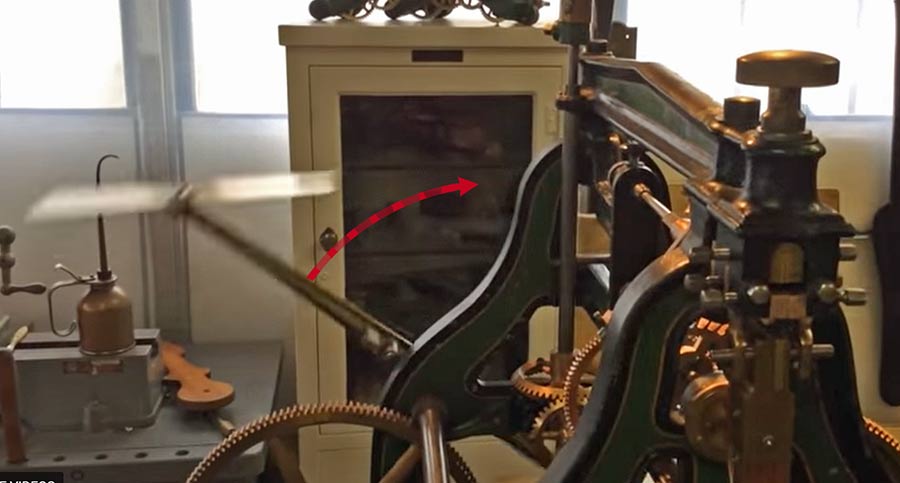
This
video
below
shows
the
striking
sequence
in
action
at
2 min
25
sec.
At
the
rear
of
the
clock
can
be
seen
the
fan
blades
start
spinning
using
the
air
resistance
to
govern
the
rate
at
which
the
hammer
strikes
the
bell.
This
clock
is
equipped
with
electric
motors
to
rewind
the
weights
automatically.
This
is a
different
type
of
escapement
but
it gives
a
good
view
of
how
the
bell-strike
mechanism
works
the
hammer. |
|
THE BILL
Mouse-over the
image to see it
transcribed.
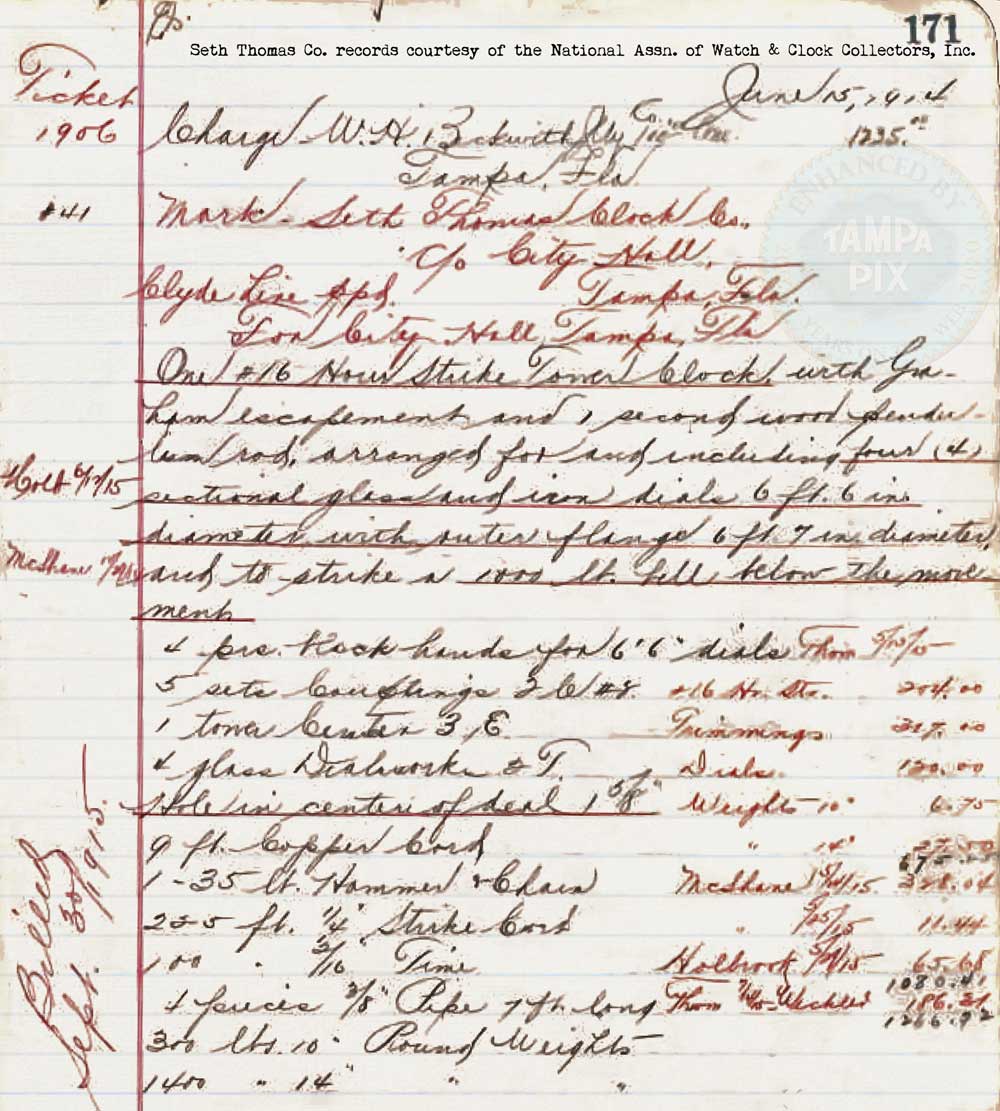
BILLING DETAIL
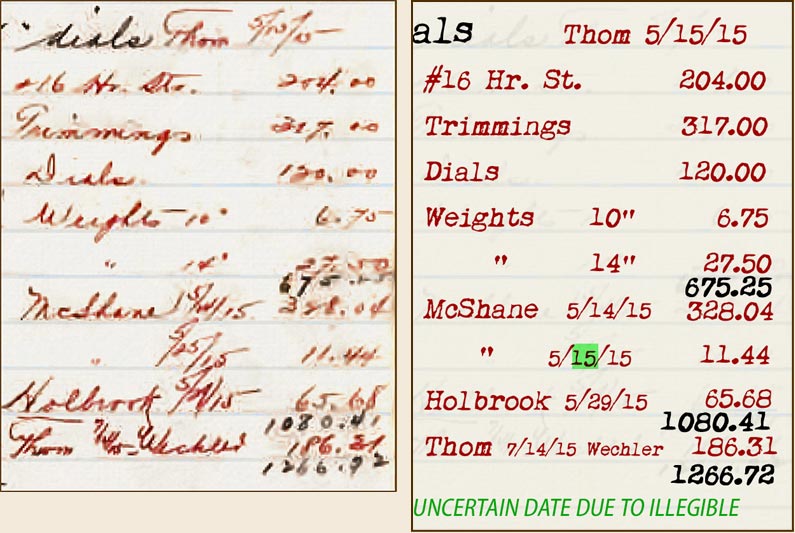
The
total
cost
for
just
Hortense
the
clock
herself
was
$675.25
which
consisted
of
the
five
amounts
in
red
above
the
subtotal;
the
clock
alone
costing
$204,
trimmings
$317,
Dials
$120
($30
each),
the
10"
weights
totaling
300
lbs.
to
drive
the
clock $6.75,
and
the
14"
weights
totaling
1,400
lbs.
to
drive
the
strike
hammer $27.50.
The charges for
her bell from
McShane Bell Co.
were $328.04 for
the bell itself
and $11.44 which
may have been
for parts, or
adding the Seth
Thomas mark to
the bell, or the
clapper (which
wouldn't be
used), or any
combination of
these items.
The "Holbrook"
charge might be
for the glass
dials.
The $1080.41
represents the
Seth Thomas
charge of 675.25
and the three
charges of
McShane &
Holbrook.
The total of
1266.72
represents the
1080.41 plus Wechler's
charge. |

For some reason,
it appears that
W. H. Beckwith
was only charged
$1,235.00, a
discount of
$31.72.
This was a 2.5%
discount.
The City
probably paid
him the full
$1,266.72 and
the difference
was his
commission.
HORTENSE'S VOICE
The melodic
voice of
Hortense was
crafted by
skilled artisans at the
McShane Bell Co.
foundry in
Baltimore, Md.
in 1914.
|
"RING
BEARERS"
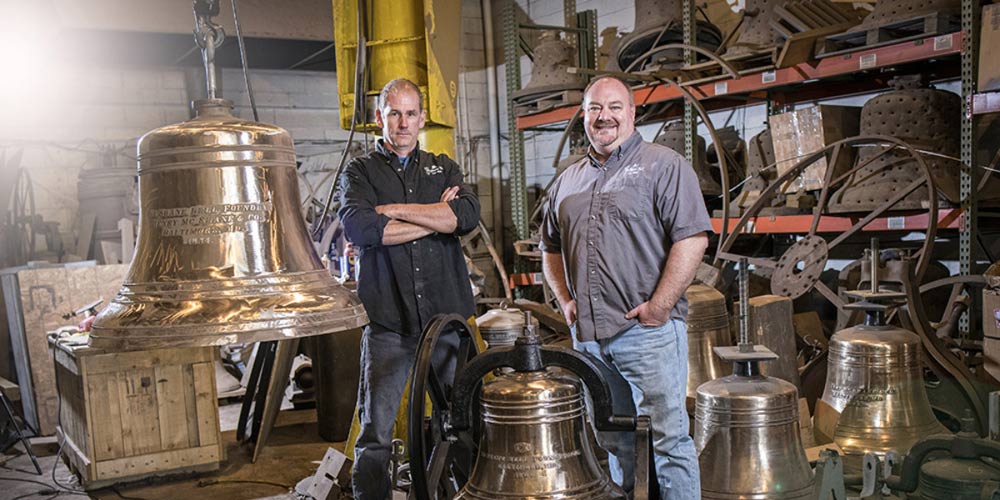 |
|
America's
longest running
bell
manufacturer
|
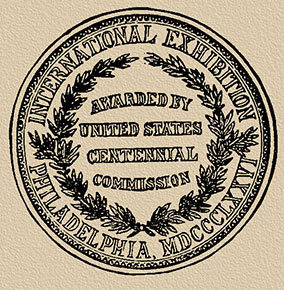 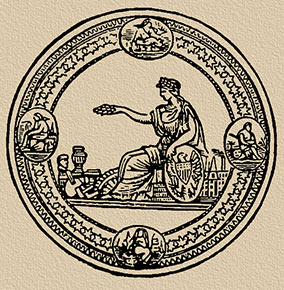 After
162 years in
business, the
longevity of
McShane Bell
Foundry takes on
added resonance.
Photo: Co-owner
William R.
Parker III,
left, with head
service tech Joe
Bennett. After
162 years in
business, the
longevity of
McShane Bell
Foundry takes on
added resonance.
Photo: Co-owner
William R.
Parker III,
left, with head
service tech Joe
Bennett.
Christopher
Myers Photo courtesy
of
2018 article in
Baltimore
Magazine
Henry McShane
was a teenage
lad from County
Louth, Ireland,
when he
immigrated to
Baltimore in
1847. He found
employment in a
brass factory
and took a shine
to the work.
Nine years
later, in 1856,
he struck out on
his own, opening
the original
McShane Bell
Foundry at
Holliday and
Centre Streets.
Initially, the
company made
pipes and
plumbing
fixtures, in
addition to
bells. But soon
its bells—with
their graceful
contours and
clear ringing
tones—overshadowed
the company’s
other output. In
particular, the
company became
known for its
peals (sets of
seven or fewer
bells) and its
chimes (sets of
eight or more
bells).
By 1873,
business was
booming, so much
so that McShane
opened a second
facility near
where The
Baltimore Sun
building now
sits on Guilford
Avenue (then
called North
Street).
An illustration
of the North
Street complex
from a company
catalogue in
1900 gives some
idea of the
scale of the
operation, which
employed some
200 workers. The
image shows
several
smoke-spewing
chimneys puffing
away while
horse-drawn
carriages,
streetcars, and
a train whiz by.
Inside, the
catalogue boasts
that, “space
will not permit
of our giving
full detail of
all the chimes
and peals we
have made,” but
does go on to
list 15 pages
worth of
recently
completed
projects,
including chimes
in Key West,
Chicago,
Detroit, and
Ontario, Canada,
and peals in
locations
ranging from
Boston to Buenos
Aires and New
Orleans to New
York City.
Images below are
from the above
mentioned McShane
Bell Foundry
catalogue printed
1900 found at
Internet Archive.
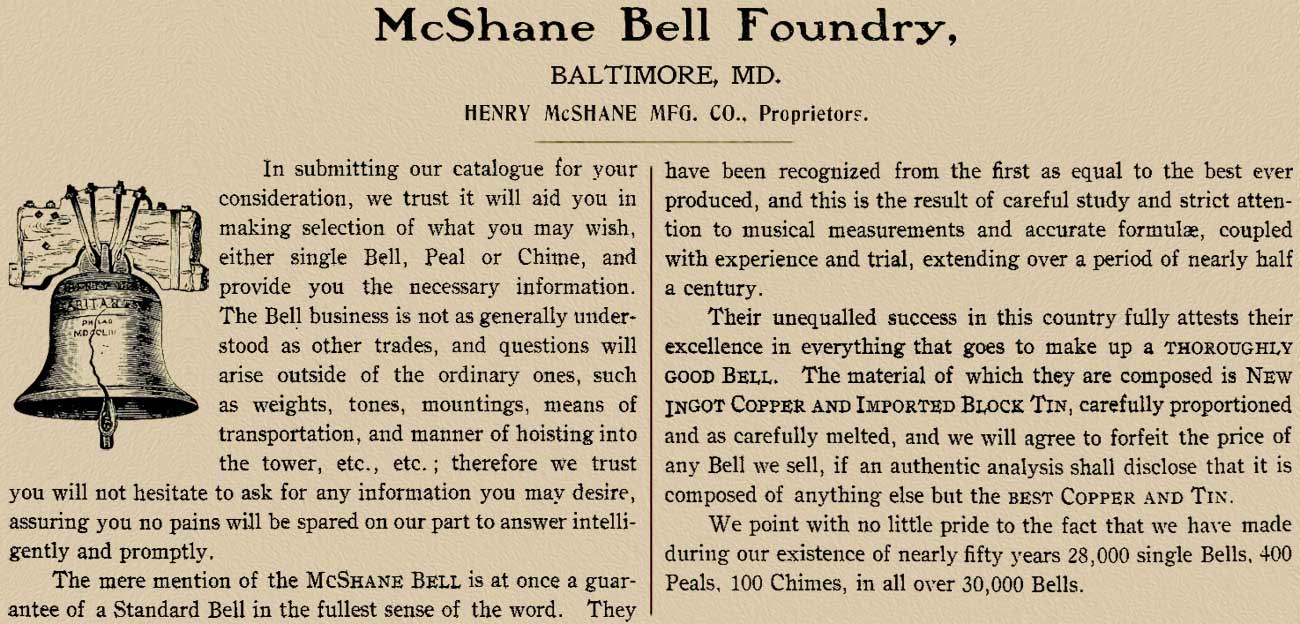
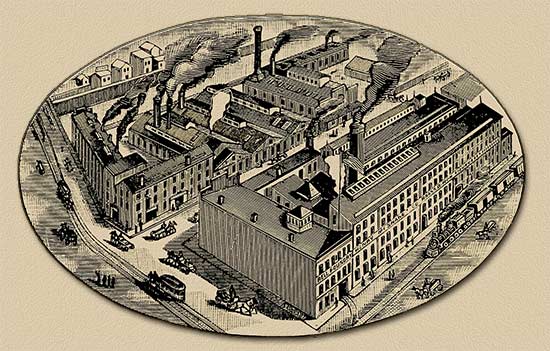 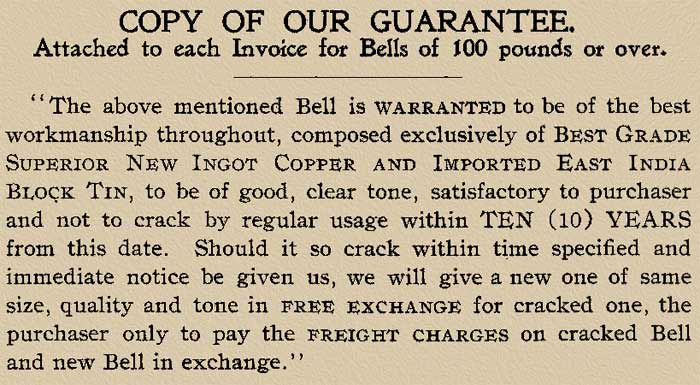
The McShane Bell
Foundry factory
complex located
at 415-441 North
Street (Guilford
Avenue),
Baltimore, MD.
Cropped from
page 53 in a 1900
McShane products trade
catalogue. Digital image
available
through the
Internet
Archive.
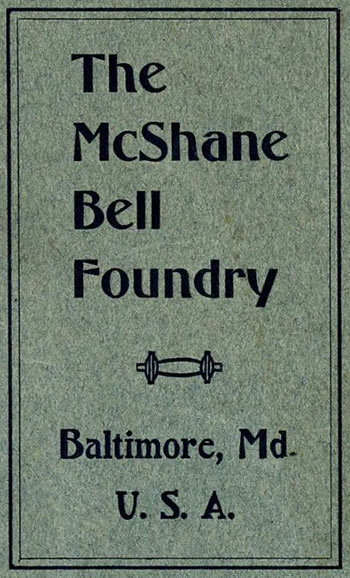
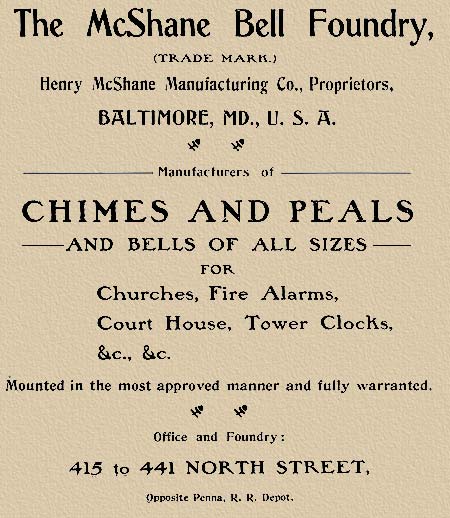 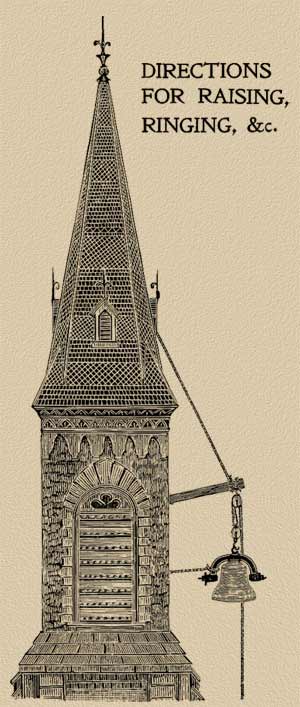
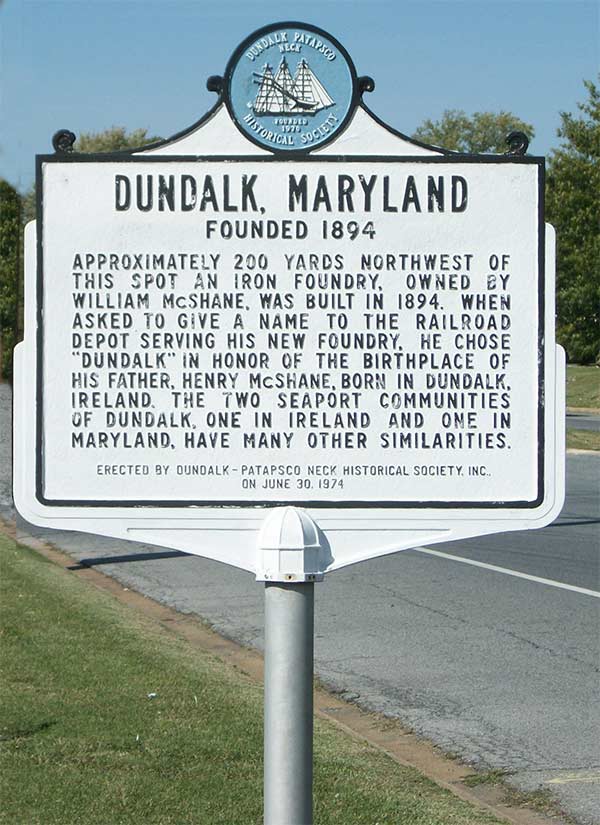
Many of
McShane's bells
are at many Baltimore
sites, too.
Though not
listed in the
1900 catalogue,
the company’s
most famous
local bell is
the “Lord
Baltimore.” Cast
in 1889, the
7,100-pound
beauty still
sits atop
Baltimore’s City
Hall and chimes
on the hour.
Other prominent
McShane bells
sound out from
perches at
Towson
University, The
Maryland State Boy choir, and
The Johns
Hopkins
University’s
Homewood campus.
After a fire
damaged part of
the North Street
foundry in 1893,
McShane decided
to move at least
part of the
company’s
operations to an
undeveloped plot
along the
Patapsco east of
Baltimore. When
the railroad
followed the
foundry out that
way two years
later, officials
asked McShane to
provide a name
for the new
depot. McShane’s
son William
James, then the
company’s vice
president, chose
to honor his
father’s Irish
hometown,
nailing a sign
to a tree near
the train
station that
read "Dundalk.”
Because many
records were
destroyed in the
Great Baltimore
Fire of 1904,
relatively
little is known
about the
company in the
early 20th
century. The
timeline becomes
clear again in
1933, when a
family by the
name of McAleer
sold the
business to
William R.
Parker Sr.
“My grandfather,
back in the
1930s, had a
tool and die
machine shop
next to the bell
foundry,”
explains Parker
III. “He was
just fascinated
by the bell
business. . . .
When [the
McAleers] took
ill, my
grandfather
stepped in and
bought the
business. It has
been in my
family ever
since.”
In 1946, after
yet another
fire, Parker Sr.
and his wife,
Edith Meyers—who
ran the front
office—moved the
foundry to a
two-story
structure on
East Federal
Street, near
Penn Station. In
1965, Parker
Sr.’s eldest
son, William R.
Parker Jr.,
joined the
family business.
And in 1979,
after the
company lost its
lease on the
Federal Street
property, Parker
Jr. moved the
foundry to a
warehouse in
Glen Burnie “on
a temporary
basis,” figuring
at least he’d be
closer to the
family home in
nearby Pasadena.
Though the story
of McShane Bell
Foundry is
marked by near
constant change,
there has been
one through
line: an
unflagging
devotion to—and
pride in—the
company’s
superior
craftsmanship.
This starts with
Henry McShane’s
original—and
somewhat
eccentric—bell-making
recipe.
The McShane Bell
Foundry is now located
in St. Louis,
Missouri. Over the
past 150 years,
the firm has
produced over
300,000 bells
for cathedrals,
churches,
municipal
buildings and
schools in
communities
around the world
- including the
7,000-pound bell
that hangs in
the dome of
Baltimore's City
Hall. It was
featured on an
episode of the
Discovery
Channel's Dirty
Jobs..
In 2019, the
company moved
its headquarters
from Glen Burnie,
near Baltimore,
Maryland to St.
Louis Missouri,
as it
centralized its
manufacturing
and shipping.
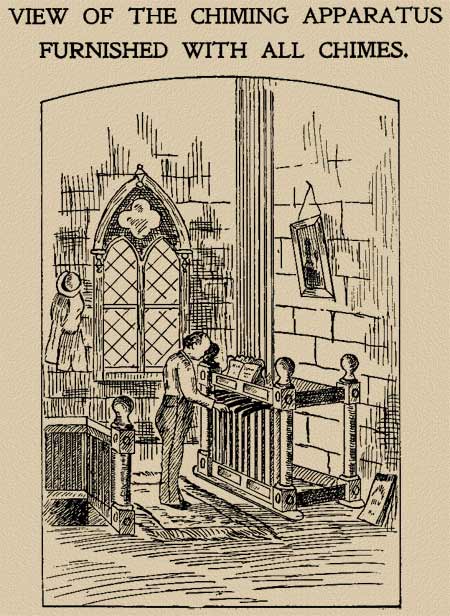
BELOW FROM
THE McSHANE
WEBSITE:
"Our bells
are produced
using time
honored
techniques
and with
state of the
art foundry
craftsmanship
and
technologies
to produce
bronze
church bells
that are as
beautiful to
hear as they
are to view.
All our
bells come
with state
of the art
mechanical
and
electrical
ringer’s
systems for
both
swinging and
stationary
bells. Our
state of the
art
equipment is
what helps
produce
their
beautiful
unmistakably
McShane
tones. Our
goal is
simple: to
produce the
best
sounding
bells with
the most up
to date
ringing
systems for
our
customers.
We approach
each project
big or small
as if it’s
our only
project.
This
accountability
and
attention to
details for
our
customers is
what sets
McShane Bell
Foundry
apart. Our
other
services
include
consultation,
inspections,
annual
maintenance
contracts,
and bell
towers.
Basically
McShane can
handle your
church bell
projects
from start
to finish
with
outstanding
results."
Some of the
above info is
parts of a
2018 article
courtesy of
Baltimore
Magazine,
Wikipedia
and the
McShane website
|
| |
|
|
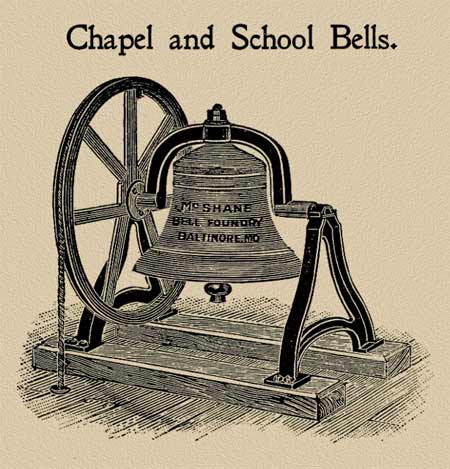
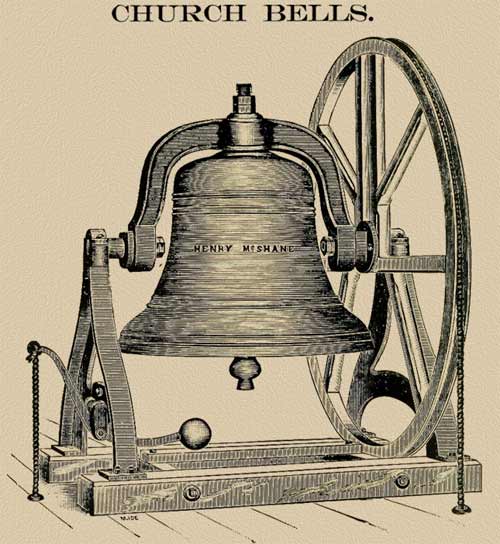
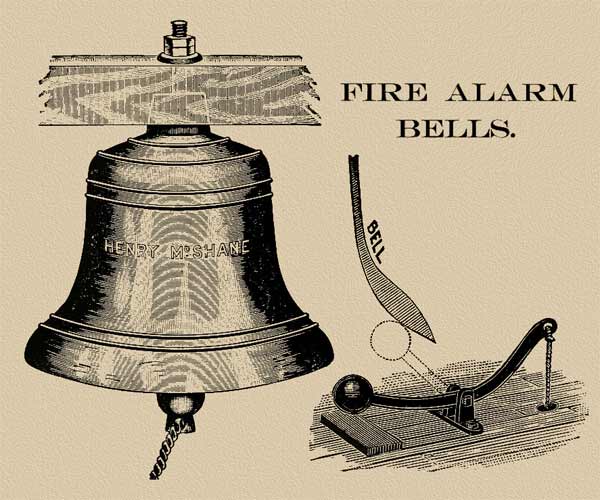
|
Below
from
Seth
Thomas
Co.
Tower
Clocks,
1911,
recommends
the
bell
room
be
separate
from
the
clock
room,
either
completely
open
all
around
or
with
louvres
or
slats
spaced
not
too
closely
together
and
just
so
they
barely
overlap,
the
floor
be
covered
with
copper
or
tin
or
some
other
weather-proof
material.
The
bell
mouth
should
be
above
the
level
of
the
base
of
the
wall
openings.
The
clock
room
should
be
sealed
from
the
weather. |
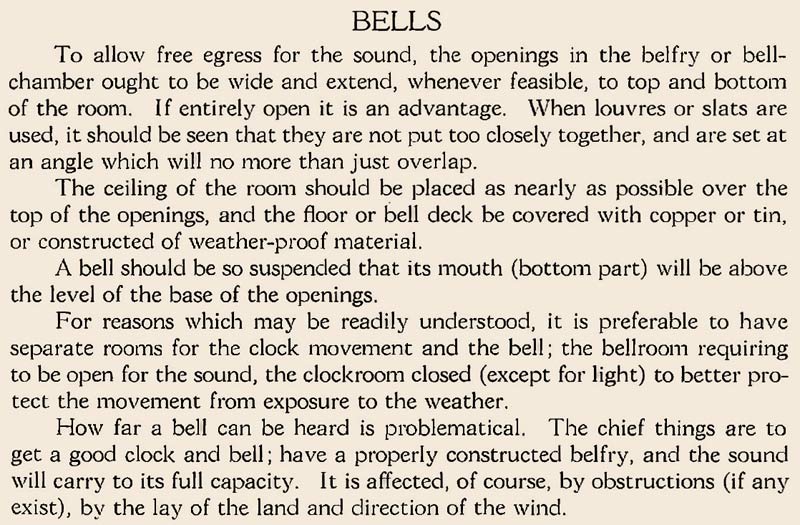 |
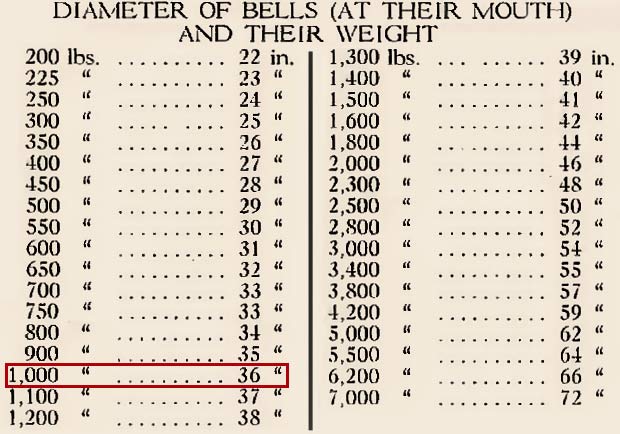 |
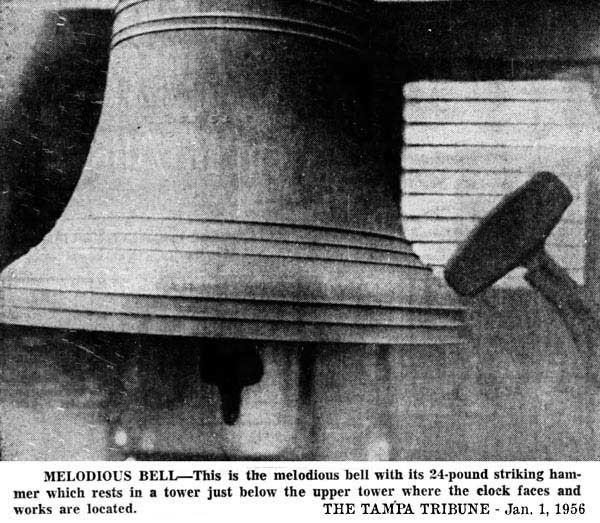
Photo below from
Apr. 27, 1989
Tampa Times
article shows
the McShane
mark.
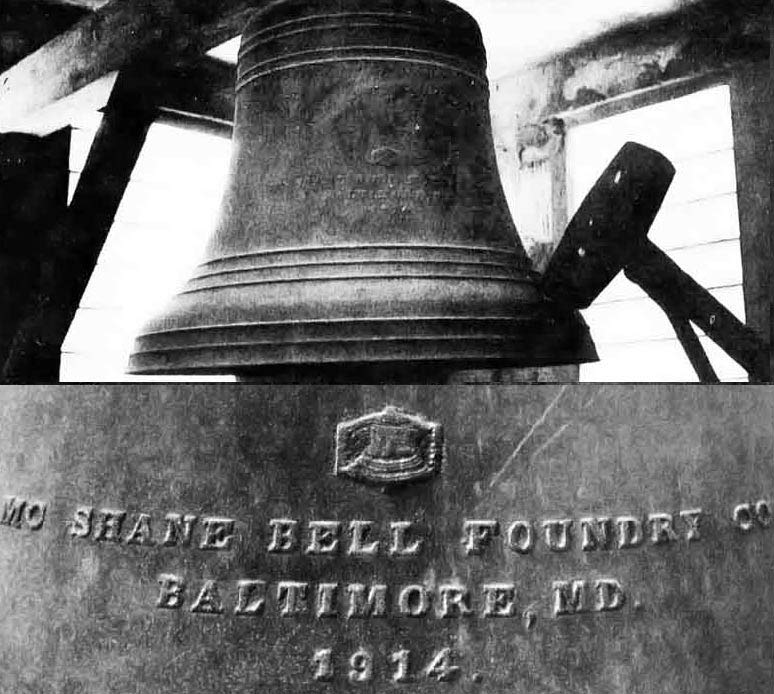
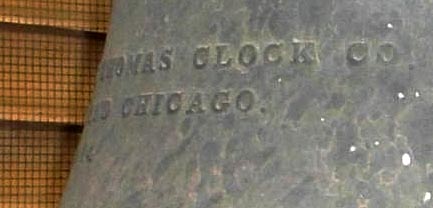
Since
only
"Thomas
Clock
Co."
is
visible,
the
second
line
probably
reads
"New
York
and
Chicago,"
the
location
of
their
corp.
offices
at
the
time.
McSHANE BELL
CO. RECORDS
Special
thanks to the
fine sales team
at McShane Bell
Co. for
going beyond
just answering
TampaPix's
question by
sending this
amazing image.
There is a close
up of the entry
for Tampa
further below.
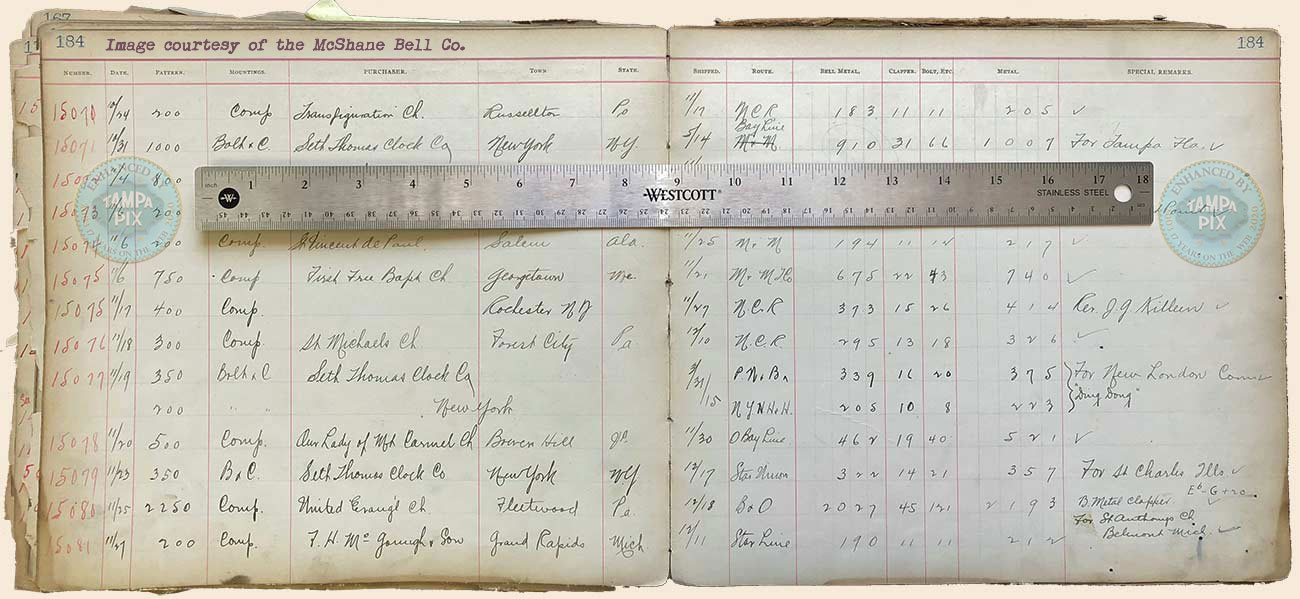
|
Tampapix
contacted the
McShane Bell Co.
in late May 2020
asking if it was
possible that
Seth Thomas
Clock Co. added
their mark to
our McShane
bell, and
included the
photos of our
City Hall bell
showing the
McShane mark and
the Seth Thomas
mark.
Their response
was prompt, the
next day the
McShane sales
team responded
with the above
incredible image
showing Seth
Thomas' order
for our 1,000
lb. City Hall
tower clock bell
on Oct. 31,
1914. They said
once a bell has
been made a
second mark
cannot be added.
They put their
mark on it and
whatever mark
the customer
requests on the
other side at
the time the
bell is made. McShane has made
bells that even
have a person's
name on it, such
as someone being
honored like a
mayor, governor,
or military
officer.
If the City of
Tampa would have
thought to name
our clock
"Hortense"
sooner, they
could have had
it put on the
bell!
|
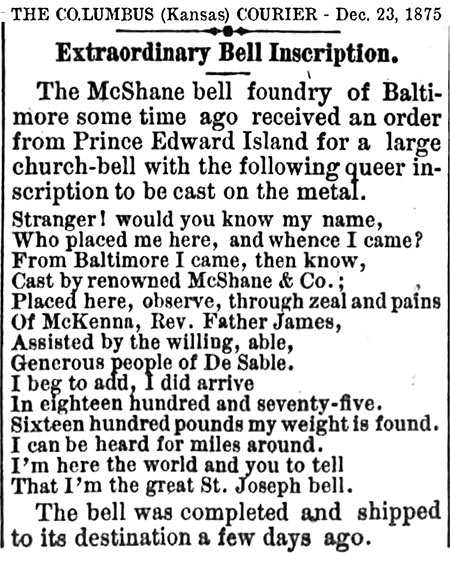
|

Our bell was
shipped via Bay
Line to Seth
Thomas Clock Co.
in New York on
May 14, 1915.
.jpg)
|
Hortense's bell
weighs 1,000
lbs. and has a
36" diameter
mouth. She
is about as tall
as she is wide.
The hammer
weighs 35
lbs and is
connected to the
clock by a chain
drive.
The Liberty bell
is 46 inches in
diameter at the
lower rim and
weighs 2,080
lbs.
Though it is not
used, Hortense's
bell has a
clapper with a
ring to tie a
rope or chain.
It could be used
to ring the bell
manually if the
hammer system is
out of order.
|
|
1915 CITY
HALL -
COUNTING THE
COST IN 2020
DOLLARS
(Values
obtained
from US
Inflation
Calculator.) |
|
| |
YE TOWNE
CRYER'S $150
DONATION
to the old
folks home
in 1913
would be
like
$3,291
in 2020.
|
| |
|
CITY HALL
total
appropriation
$300,000
in 1914
would be
like
$7,764,330
in 2020
includes:
LAND
purchases:
$
65,000
tot. in
1914 is
like
$1,682,272
in
2020 |
| |
|
BUILDING
COSTS
$235,000
in
1914 is like
$6, 082,058 in 2020 |
|
| |
|
HORTENSE:
Seth
Thomas clock
bill was
$1,266.72,
in 2020 dollars
that's
around
$32,791.
Includes
$339 for
McShane
bell, would
be like
$8,773
in 2020. |
|
| |
|
BECKWITH'S
DISCOUNT
or HIS
PROFIT:
$31.72
in 1914 is
like
$821
in 2020. |
|
|
|
1915 CITY
HALL -
COUNTING THE
COST IN 2022
DOLLARS
(Values
obtained
from US
Inflation
Calculator.) |
|
| |
YE TOWNE
CRYER'S $150
DONATION
to the old
folks home
in 1913
would be
like
$4,434
in 2022.
|
| |
|
CITY HALL
total
appropriation
$300,000
in 1914
would be
like
$8,779,650
in 2022
includes:
LAND
purchases:
$
65,000
tot. in
1914 is
like
$1,902,257
in
2022 |
| |
|
BUILDING
COSTS
$235,000
in 1914
is like
$6,877,392 in 2022 |
|
| |
|
HORTENSE:
Seth
Thomas clock
bill was
$1,266.72,
in 2022 dollars
that's
around
$37,071.
Includes
$339 for
McShane
bell, would
be like
$8,773
in 2022. |
|
| |
|
BECKWITH'S
DISCOUNT
or HIS
PROFIT:
$31.72
in 1914 is
like
$928
in 2022. |
|
|
|
|
|
HISTORY REWRITTEN - Tampa's Old
City Hall Clock
When, Why, and How It Really
Happened
|